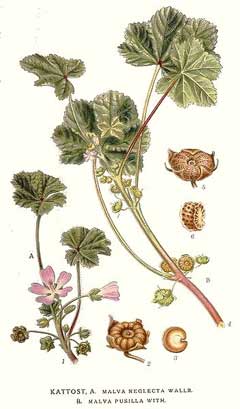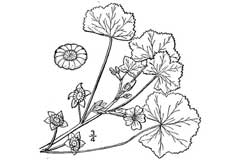 |
|
http://commons.wikimedia.org/wiki/File:234_Malva_neglecta.jpg |
 |
| USDA-NRCS PLANTS Database |
Translate this page:
Summary
Physical Characteristics

 Malva pusilla is a ANNUAL growing to 0.3 m (1ft).
Malva pusilla is a ANNUAL growing to 0.3 m (1ft).
See above for USDA hardiness. It is hardy to UK zone 6 and is not frost tender. It is in flower from June to September, and the seeds ripen from August to October. The species is hermaphrodite (has both male and female organs) and is pollinated by Insects. The plant is self-fertile.
Suitable for: light (sandy), medium (loamy) and heavy (clay) soils and prefers well-drained soil. Suitable pH: mildly acid, neutral and basic (mildly alkaline) soils. It can grow in semi-shade (light woodland) or no shade. It prefers moist soil. The plant can tolerates strong winds but not maritime exposure.
UK Hardiness Map
US Hardiness Map
Synonyms
M. rotundifolia. L.
Plant Habitats
Cultivated Beds;
Edible Uses
Edible Parts: Leaves Seed
Edible Uses:
Leaves - raw or cooked[74, 145]. A mild pleasant flavour, it can be used in quantity and makes an excellent salad plant. It is possibly the best for flavour in this genus though it is much lower yielding than the annual M. verticillata 'Crispa' or the perennials M. alcea and M. moschata[K]. Seed - raw or cooked[74, 105]. Best used before it is fully mature, the seed has a pleasant nutty taste but it is rather small and very fiddly to harvest[K].
References More on Edible Uses
Medicinal Uses
Plants For A Future can not take any responsibility for any adverse effects from the use of plants. Always seek advice from a professional before using a plant medicinally.
Demulcent Poultice Urinary
The leaves are demulcent and have occasionally been used internally in the treatment of inflammations of the digestive and urinary systems[4]. Externally they have been used as a poultice for bruises, inflammations, piles etc[4, 240]. This plant is less active than the common mallow (M. sylvestris) and the marsh mallow (Althaea officinalis)[4]. The seed is demulcent[240]. It is used in the treatment of coughs, bronchitis, ulceration of the bladder and haemorrhoids[240]. It is applied externally in the treatment of skin diseases[240].
References More on Medicinal Uses
The Bookshop: Edible Plant Books
Our Latest books on Perennial Plants For Food Forests and Permaculture Gardens in paperback or digital formats.

Edible Tropical Plants
Food Forest Plants for Hotter Conditions: 250+ Plants For Tropical Food Forests & Permaculture Gardens.
More

Edible Temperate Plants
Plants for Your Food Forest: 500 Plants for Temperate Food Forests & Permaculture Gardens.
More

More Books
PFAF have eight books available in paperback and digital formats. Browse the shop for more information.
Shop Now
Other Uses
Dye Teeth
Cream, yellow and green dyes can be obtained from the plant and the seed heads[168]. The root can be used as a toothbrush[74].
Special Uses
Food Forest
References More on Other Uses
Cultivation details
A very easily grown plant, succeeding in ordinary garden soil[1], though it prefers a reasonably well-drained and moderately fertile soil in a sunny position[200]. This plant has been extensively cultivated as a pot-herb in some countries[4]. Plants seem to be immune to the predations of rabbits[233]. Plants are prone to infestation by rust fungus[200].
References Carbon Farming Information and Carbon Sequestration Information
Temperature Converter
Type a value in the Celsius field to convert the value to Fahrenheit:
Fahrenheit:
The PFAF Bookshop
Plants For A Future have a number of books available in paperback and digital form. Book titles include Edible Plants, Edible Perennials, Edible Trees,Edible Shrubs, Woodland Gardening, and Temperate Food Forest Plants. Our new book is Food Forest Plants For Hotter Conditions (Tropical and Sub-Tropical).
Shop Now
Plant Propagation
Seed - sow early spring in situ. Germination should take place within 2 weeks.
Other Names
If available other names are mentioned here
Native Range
TEMPERATE ASIA: Afghanistan, Iran, Iraq (north), Turkey, Russian Federation-Ciscaucasia (Ciscaucasia), Armenia, Azerbaijan, Georgia, Russian Federation-Western Siberia (Western Siberia), Russian Federation-Eastern Siberia (Eastern Siberia), Kazakhstan, Kyrgyzstan, Tajikistan EUROPE: Denmark, Norway, Sweden, Austria, Belgium, Czech Republic, Germany, Hungary, Netherlands, Poland, Slovakia, Russian Federation (European part), Belarus, Estonia, Lithuania, Latvia, Moldova, Ukraine (incl. Krym), Bulgaria, Bosnia and Herzegovina, Greece, Croatia, Italy, Montenegro, Romania, Serbia, Slovenia, Portugal
Weed Potential
Right plant wrong place. We are currently updating this section.
Please note that a plant may be invasive in one area but may not in your area so it's worth checking.
Conservation Status
IUCN Red List of Threatened Plants Status :

| Related Plants
|
| Latin Name | Common Name | Habit | Height | Hardiness | Growth | Soil | Shade | Moisture | Edible | Medicinal | Other |
| Abelmoschus esculentus | Okra | Annual | 1.0 |
5-11
| | LMH | N | M | 4 | 3 | 2 |
| Abelmoschus manihot | Aibika | Perennial | 3.0 |
8-11
| F | LMH | N | M | 4 | 1 | 2 |
| Abelmoschus moschatus | Musk Mallow,Musk Okra | Perennial | 2.0 |
8-11
| F | LMH | N | M | 2 | 3 | 3 |
| Abroma augusta | Cotton Abroma. Perennial Indian Hemp. | Shrub | 3.0 |
10-12
| F | LMH | N | M | 0 | 3 | 4 |
| Abutilon megapotamicum | Trailing Abutilon | Shrub | 2.0 |
7-10
| F | LMH | SN | M | 4 | 0 | 0 |
| Abutilon ochsenii | | Shrub | 4.0 |
7-10
| | LMH | SN | M | 3 | 0 | |
| Abutilon pictum | Abutilon, Parlour Maple, Flowering Maple, Spotted | Shrub | 5.0 |
8-10
| M | LMH | SN | M | 3 | 0 | |
| Abutilon purpurascens | | Shrub | 2.4 |
8-11
| | LMH | SN | DM | 2 | 0 | |
| Abutilon species | | Shrub | 3.0 |
7-10
| | LMH | SN | M | 3 | 0 | |
| Abutilon theophrasti | China Jute, Velvetleaf, Butterprint Buttonweed Jute, China Mallow, Indian Velvet Leaf | Annual | 1.0 |
0-0
| | LMH | SN | DM | 3 | 2 | 4 |
| Abutilon vitifolium | | Shrub | 8.0 |
7-10
| | LMH | SN | M | 3 | 0 | |
| Abutilon x hybridum | Chinese Lantern, Flowering Maple | Shrub | 3.0 |
9-11
| F | LMH | SN | M | 3 | 0 | 0 |
| Abutilon x milleri | Trailing Abutilon | Shrub | 3.0 |
7-10
| | LMH | SN | M | 3 | 0 | |
| Abutilon x suntense | | Shrub | 8.0 |
7-10
| F | LMH | SN | M | 3 | 0 | |
| Adansonia digitata | Baobab, Judas Fruit, Monkey Bread Tree | Tree | 20.0 |
10-12
| S | LMH | N | DM | 3 | 3 | 4 |
| Alcea rosea | Hollyhock | Perennial | 2.4 |
5-9
| F | LMH | N | DM | 3 | 2 | 3 |
| Althaea cannabina | Palm-leaf marshmallow | Perennial | 1.8 |
4-8
| | LMH | N | DM | 0 | 0 | 1 |
| Althaea officinalis | Marsh Mallow, Common marshmallow | Perennial | 1.2 |
3-7
| M | LMH | N | DM | 5 | 5 | 3 |
| Anoda cristata | Crested Anoda | Annual | 0.8 |
8-11
| F | LMH | N | DM | 2 | 0 | 0 |
| Bombax ceiba | Red Silk Cotton Tree, Kapok Tree | Tree | 25.0 |
10-12
| M | LMH | N | DM | 2 | 2 | 4 |
| Burretiodendron hsienmu | Hsienmu wood | Tree | 35.0 |
10-12
| S | LMH | N | M | 0 | 0 | 4 |
| Callirhoe digitata | Finger Poppy Mallow, Winecup | Perennial | 0.9 |
4-8
| | L | N | DM | 2 | 0 | |
| Callirhoe involucrata | Poppy Mallow, Purple poppymallow, Winecup, Finger Poppy Mallow | Perennial | 0.2 |
4-8
| M | L | N | DM | 3 | 2 | 0 |
| Callirhoe leiocarpa | Tall Poppy-Mallow | Annual | 0.9 |
5-9
| | L | N | DM | 2 | 0 | |
| Ceiba aesculifolia | Pochote | Tree | 25.0 |
10-12
| M | LMH | N | DM | 2 | 1 | 4 |
| Ceiba pentandra | Kapok Tree, Cotton Tree, Suma'ma | Tree | 50.0 |
10-12
| F | MH | N | DM | 3 | 3 | 5 |
| Clappertonia ficifolia | Bolo Bolo | Shrub | 2.5 |
10-12
| F | LM | N | MWe | 0 | 1 | 4 |
| Cola acuminata | Cola Nut, Kola, Bissy Nut | Tree | 20.0 |
10-12
| M | LMH | N | M | 3 | 4 | 2 |
| Cola nitida | Cola Nut, Kola, Bissy Nuts | Tree | 20.0 |
10-12
| S | LMH | SN | DM | 3 | 4 | 2 |
| Durio dulcis | Durian Marangang, Merangang, Red Durian, Tutong, Lahong | Tree | 30.0 |
11-12
| M | LMH | N | M | 4 | 0 | 2 |
|
|
Growth: S = slow M = medium F = fast. Soil: L = light (sandy) M = medium H = heavy (clay). pH: A = acid N = neutral B = basic (alkaline). Shade: F = full shade S = semi-shade N = no shade. Moisture: D = dry M = Moist We = wet Wa = water.
Now available:
Food Forest Plants for Mediterranean Conditions
350+ Perennial Plants For Mediterranean and Drier Food Forests and Permaculture Gardens.
[Paperback and eBook]
This is the third in Plants For A Future's series of plant guides for food forests tailored to
specific climate zones. Following volumes on temperate and tropical ecosystems, this book focuses
on species suited to Mediterranean conditions—regions with hot, dry summers and cool, wet winters,
often facing the added challenge of climate change.
Read More
Expert comment
Author
Sm.
Botanical References
1774
Links / References
For a list of references used on this page please go here
Readers comment
| Add a comment |
|
If you have important information about this plant that may help other users please add a comment or link below. Only comments or links that are felt to be directly relevant to a plant will be included. If you think a comment/link or information contained on this page is inaccurate or misleading we would welcome your feedback at [email protected]. If you have questions about a plant please use the Forum on this website as we do not have the resources to answer questions ourselves.
* Please note: the comments by website users are not necessarily those held by PFAF and may give misleading or inaccurate information.
To leave a comment please Register or login here All comments need to be approved so will not appear immediately.
|
|